Understanding Spring MVC
- Details
- Written by Nam Ha Minh
- Last Updated on 21 November 2023 | Print Email
Spring framework makes the development of web applications very easy by providing the Spring MVC module. Spring MVC module is based on two most popular design patterns - Front controller and MVC.
In this article, firstly we learn about the Front controller and MVC design pattern and then explore the details of Spring MVC module in detail, its architecture, and various components and finally we build a simple web application using Eclipse IDE.
Table of Content
- Architecture
- Dispatcher Servlet
- Spring Application Context
- Handler mappings
- Controllers
- ModelAndView and ViewResolver
- Sample application
- Conclusion
1. Spring MVC Architecture
Before going into details of Spring MVC architecture, let us first look at the two popular design patterns used for web development.
Front Controller design pattern
This design pattern enforces a single point of entry for all the incoming requests. All the requests are handled by a single piece of code which can then further delegate the responsibility of processing the request to further application objects.
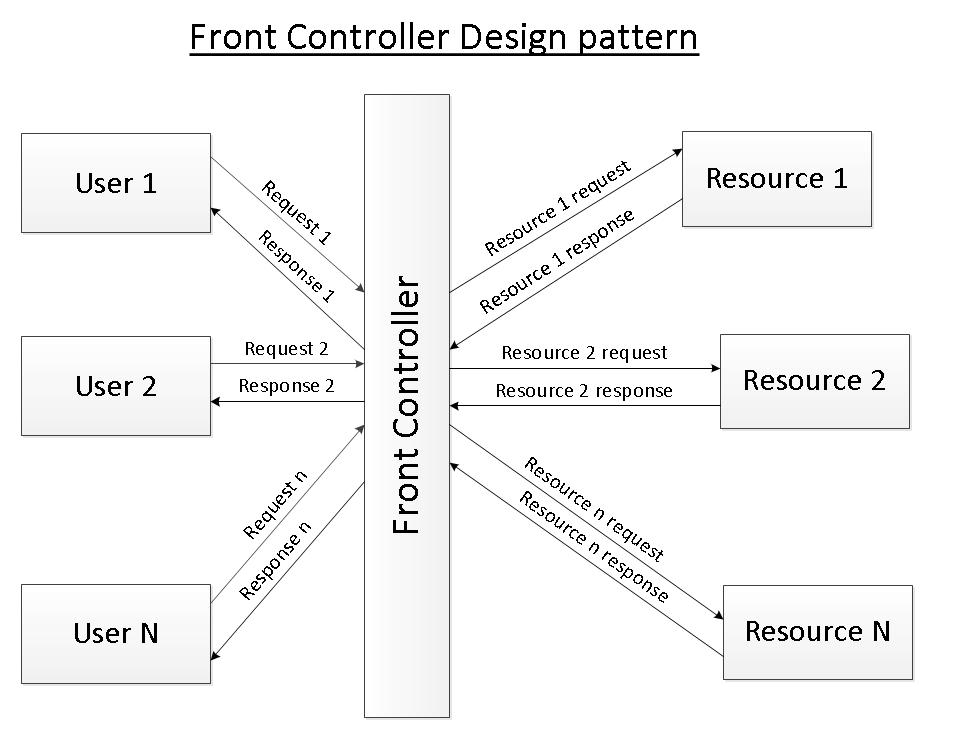
Front Controller Design Pattern
MVC design pattern
This design pattern helps us develop loosely coupled application by segregating various concerns into different layers. MVC design pattern enforces the application to be divided into three layers, Model, View and Controller.
Model: This represents the application data.
View: This represents the application’s user interface. View takes model as the input and renders it appropriately to the end user.
Controller: The controller is responsible for handling the request and generating the model and selecting the appropriate view for the request.
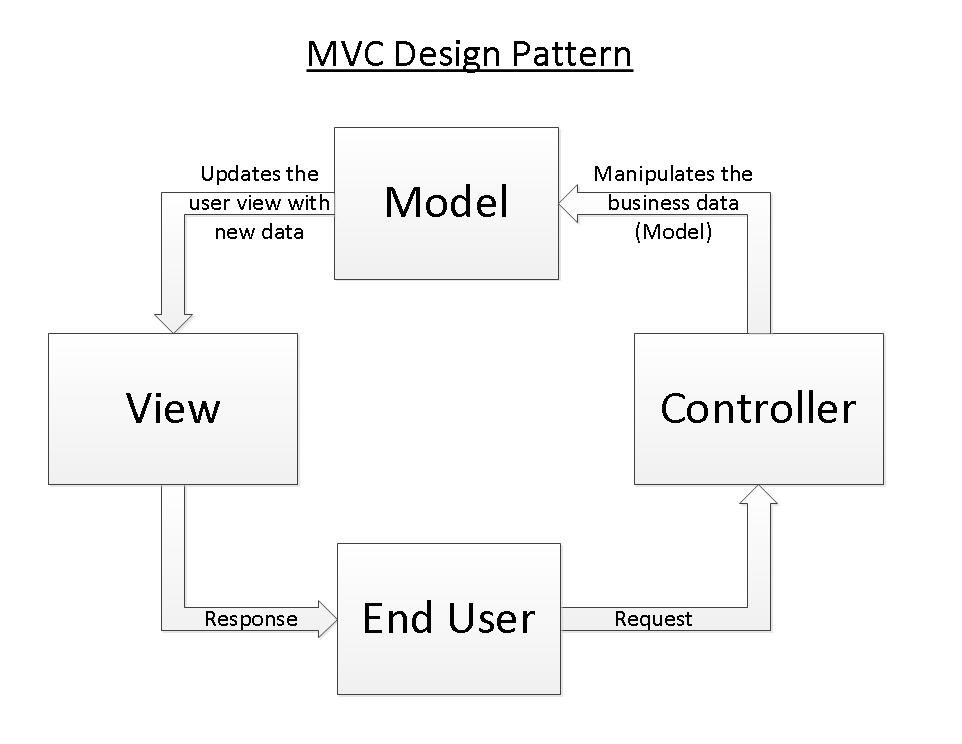
MVC Design Pattern
Spring’s MVC module
Spring’s MVC module is based on front controller design pattern followed by MVC design pattern. All the incoming requests are handled by the single servlet named DispatcherServlet which acts as the front controller in Spring’s MVC module. The DispatcherServlet then refers to the HandlerMapping to find a controller object which can handle the request. DispatcherServlet then dispatches the request to the controller object so that it can actually perform the business logic to fulfil the user request. (Controller may delegate the responsibility to further application objects known as service objects). The controller returns an encapsulated object containing the model object and the view object (or a logical name of the view). In Spring’s MVC, this encapsulated object is represented by class ModelAndView. In case ModelAndView contains the logical name of the view, the DispatcherServlet refers the ViewResolver to find the actual View object based on the logical name. DispatcherServlet then passes the model object to the view object which is then rendered to the end user.
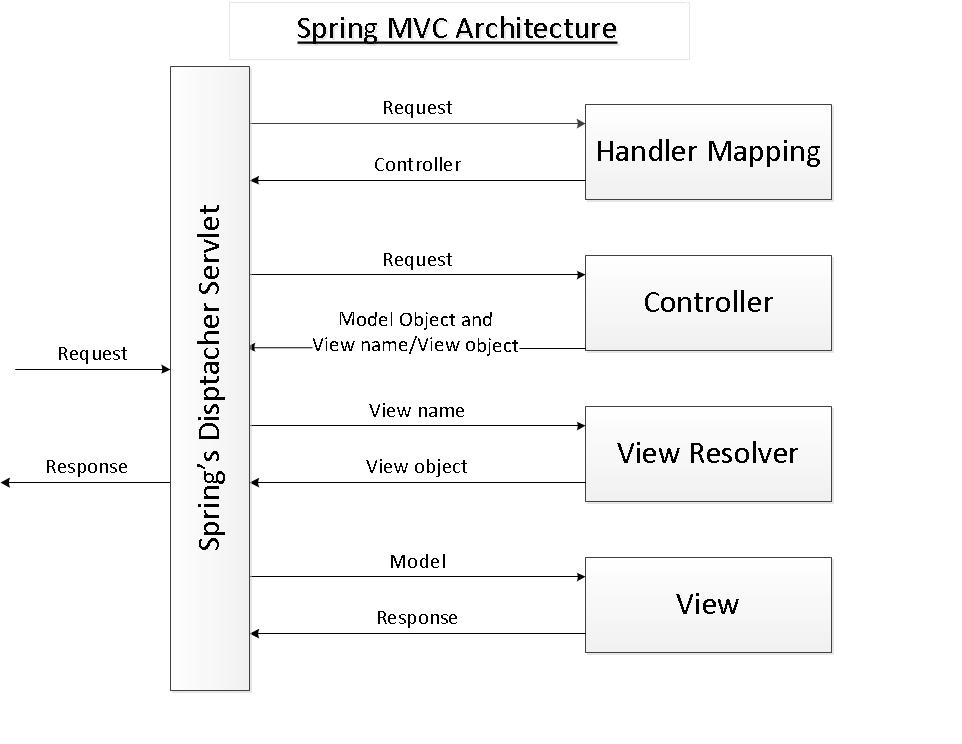
Spring MVC Architecture
2. Dispatcher Servlet
DispatcherServlet acts as the front controller in the Spring’s MVC module. All the user requests are handled by this servlet. Since this is like any other servlet, it must be configured in the application’s web deployment descriptor file i.e. web.xml.
<web-app xsi:schemaLocation="http://java.sun.com/xml/ns/javaee
http://java.sun.com/xml/ns/javaee/web-app_2_5.xsd"
id="WebApp_ID"
version="2.5"
xmlns:xsi="http://www.w3.org/2001/XMLSchema-instance"
xmlns="http://java.sun.com/xml/ns/javaee"
xmlns:web="http://java.sun.com/xml/ns/javaee/web-app_2_5.xsd">
<display-name>Library</display-name>
<servlet>
<servlet-name>myLibraryAppFrontController</servlet-name>
<servlet-class>org.springframework.web.servlet.DispatcherServlet</servlet-class>
<load-on-startup>1</load-on-startup>
</servlet>
<servlet-mapping>
<servlet-name>myLibraryAppFrontController</servlet-name>
<url-pattern>*.htm</url-pattern>
</servlet-mapping>
<welcome-file-list>
<welcome-file>welcome.htm</welcome-file>
</welcome-file-list>
</web-app>We have named the servlet as “myLibraryAppFrontController”. The URI pattern in the servlet mapping section is “*.htm”. Thus all the requests matching the URI pattern will be handled by myLibraryAppFrontController.
3. Spring Application Context
- Default Application context file
- User defined application context file
- Multiple application context files
Default Application context file
By default the dispatcher servlet loads the Spring application context from XML file with name [servlet name]-servlet.xml. Thus when our servlet myLibraryAppFrontController is loaded by the container, it will load the Spring application context from XML file “/WEB-INF/myLibraryAppFrontController-servlet.xml”.
User defined application context file
We can override the name and location of the default XML file by providing the initialization parameters to the dispatcher servlet. The name of the initialization parameter is contextConfigLocation. The parameter value specifies the name and location of the application context which needs to be loaded by the container.
<servlet>
<servlet-name>myLibraryAppFrontController</servlet-name>
<servlet-class>org.springframework.web.servlet.DispatcherServlet</servlet-class>
<init-param>
<param-name>contextConfigLocation</param-name>
<param-value>classpath:libraryAppContext.xml</param-value>
</init-param>
<load-on-startup>1</load-on-startup>
</servlet>In the above configuration of myLibraryAppFrontController, when the container initializes the dispatcher servlet, it will load the Spring application context from XML file “classpath:libraryAppContext.xml” instead of “/WEB-INF/myLibraryAppFrontController-servlet.xml”.
Multiple application context files
It is a good practice to split the application into multiple logical units and have multiple application context file. Thus on servlet initialization we need to load all these application context files. It is possible to load the Spring application context from multiple XML file as shown below:
<servlet>
<servlet-name>myLibraryAppFrontController</servlet-name>
<servlet-class>org.springframework.web.servlet.DispatcherServlet</servlet-class>
<init-param>
<param-name>contextConfigLocation</param-name>
<param-value>classpath:libraryAppContext.xml
classpath:books.xml
classpath:chapters.xml
classpath:titles.xml</param-value>
</init-param>
<load-on-startup>1</load-on-startup>
</servlet>In the above servlet configuration, we have provided multiple XML files as initialization parameter value. All these XML files will be loaded by the container on initialization of the servlet myLibraryAppFrontController.
4. Spring Handler mappings
As the name specifies, the handler mapping maps the request with the corresponding request handler (in fact handler execution chain). When a request comes to Spring’s dispatcher servlet, it hands over the request to the handler mapping. Handler mapping then inspects the request and identifies the appropriate handler execution chain and delivers it to dispatcher servlet. The handler execution chain contains handler that matches the incoming request and optionally contains the list of interceptors that are applied for the request. Dispatcher servlet then executes the handlers and any associated handler interceptor.
There are number of implementation of hander mapping provided by Spring’s MVC module. Some of these are described below. All the handler mappings classes implement the interface org.springframework.web.servlet.HandlerMapping.
BeanNameUrlHandlerMapping
This implementation of handler mapping matches the URL of the incoming request with the name of the controller beans. The matching bean is then used as the controller for the request. This is the default handler mapping used by the Spring’s MVC module i.e. in case the dispatcher servlet does not find any handler mapping bean defined in Spring’s application context then the dispatcher servlet uses BeanNameUrlHandlerMapping.
Let us assume that we have three web pages in our application. The URL of the pages are:
- http://servername:portnumber/ApplicationContext/welcome.htm
- http://servername:portnumber/ApplicationContext/listBooks.htm
- http://servername:portnumber/ApplicationContext/displayBookContent.htm
The controllers which will perform the business logic to fulfil the request made to the above pages are:
- net.codejava.frameorks.spring.mvc.controller.WelcomeController
- net.codejava.frameorks.spring.mvc.controller.ListBooksController
- net.codejava.frameorks.spring.mvc.controller.DisplayBookTOCController
Thus we need to define the controllers in Spring’s application context file such that the name of the controller matches the URL of the request. The controller beans in XML configuration file will look as below.
<bean
name="/welcome.htm"
class="net.codejava.frameorks.spring.mvc.controller.WelcomeController" />
<bean
name="/listBooks.htm"
class="net.codejava.frameorks.spring.mvc.controller.ListBooksController"/>
<bean
name="/displayBookTOC.htm"
class="net.codejava.frameorks.spring.mvc.controller.DisplayBookTOCController"/>Note that we need not define the BeanNameUrlHandlerMapping in Spring’s application context file because this is the default one being used.
Spring Boot E-Commerce Ultimate Course
Code Real-life Shopping Website with Java and Spring Boot. Full-stack Development. Hands-on Practices. Job-ready Skills.
SimpleUrlHandlerMapping
The BeanNameUrlHandlerMapping puts a restriction on the name of the controller beans that they should match the URL of the incoming request. SimpleUrlHandlerMapping removes this restriction and maps the controller beans to request URL using a property “mappings”.
<bean
id="myHandlerMapping"
class="org.springframework.web.servlet.handler.SimpleUrlHandlerMapping">
<property name="mappings">
<props>
<prop key="/welcome.htm">welcomeController</prop>
<prop key="/listBooks.htm">listBooksController</prop>
<prop key="/displayBookTOC.htm">displayBookTOCController</prop>
</props>
</property>
</bean>
<bean name="welcomeController"
class="net.codejava.frameorks.spring.mvc.controller.WelcomeController"/>
<bean name="listBooksController"
class="net.codejava.frameorks.spring.mvc.controller.ListBooksController"/>
<bean name="displayBookTOCController"
class="net.codejava.frameorks.spring.mvc.controller.DisplayBookTOCController"/>The key of the <prop> element is the URL pattern of the incoming request. The value of the <prop> element is the name of the controller bean which will perform the business logic to fulfil the request. SimpleUrlHandlerMapping is one of the most commonly used handler mapping.
5. Spring Controllers
Controller is the actual piece of code which performs the business logic to fulfil the incoming request. Controllers may delegate this responsibility to further service objects as well. All the user defined controllers must either implement the interface Controller or extend the abstract class AbstractController. The user defined controllers need to override the method handleRequestInternal. The method handleRequestInternal takes HttpServletRequest and HTTPServletResponse as the input and returns an object of ModelAndView.
In the Spring’s application context file, we have defined a user defined custom controller named welcomeController. As per the SimpleUrlHandlerMApping, all the requests matching URL pattern /welcome.htm will be handled by this controller. The WelcomeController must extend AbstractController and provide the definition of method handleRequestInternal. Thus WelcomeController looks as below:
public class WelcomeController extends AbstractController {
@Override
protected ModelAndView handleRequestInternal(HttpServletRequest arg0,
HttpServletResponse arg1) throws Exception {
return new ModelAndView("welcome");
}
}MultiActionController
In any medium to large size enterprise web application, there are quite a number of web pages. To fulfil the request for those web pages we need to define multiple controllers, one each for a web page. And sometimes the business logic is executed to fulfil those requests is similar. This creates redundancy of business logic in multiple controllers and makes the maintenance difficult.
Spring’s MVC module provides a way to deal with this scenario by providing a single controller fulfilling the request for multiple web pages. Such a controller is known as Multi Action Controller. A user defined multi action controller should extend the class org.springframework.web.servlet.mvc.multiaction.MultiActionController. Each method in user defined multi action controller contains the logic to fulfil the request for a particular web page.
By default, the URL of the incoming request (excluding the extension part) will be matched against the name of the method in multi action controller and the matching method will perform the business logic for the incoming request. So for the incoming request with URL /welcome.htm, the method name containing the business logic will be welcome.
Let us assume that the multi action controller in our application is MyMultiActionController which fulfils the request for the three web pages with URL /welcome.htm, /listBooks.htm and /displayBookTOC.htm. Thus the class should extend the MultiActionController and have three methods with name welcome, listBooks and displayBookTOC. The controller will look as below:
public class MyMultiActionController extends MultiActionController {
// This method will server all the request matching URL pattern /welcome.htm
public ModelAndView welcome(HttpServletRequest request,
HttpServletResponse response) {
// Business logic goes here
// Return an object of ModelAndView to DispatcherServlet
return new ModelAndView("Welcome");
}
// This method will server all the request matching URL pattern
// /listBooks.htm
public ModelAndView listBooks(HttpServletRequest request,
HttpServletResponse response) {
// Business logic goes here
// Return an object of ModelAndView to DispatcherServlet
return new ModelAndView("listBooks");
}
// This method will server all the request matching URL pattern
// /displayBookTOC.htm
public ModelAndView displayBookTOC(HttpServletRequest request,
HttpServletResponse response) {
// Business logic goes here
// Return an object of ModelAndView to DispatcherServlet
return new ModelAndView("displayBookTOC");
}
}MethodNameResolver
Spring MVC provides a number of other method name resolvers that helps to resolve the multi action controller method name based on the request. Some of these are:
ParameterMethodNameResolver
A particular parameter in the request contains the method name. The name of the parameter is defined in the Spring’s application context file while defining ParameterMethodNameResolver. In the example below, the parameter controllerMethod in the request will determine the multi action controller method which will be executed to fulfil the request.
<bean name="parameterMethodNameResolver"
class="org.springframework.web.servlet.mvc.multiaction.ParameterMethodNameResolver">
<property name="paramName">
<value>controllerMethod</value>
</property>
</bean>Notes: The request for a particular web page should now contain an additional parameter with name “controllerMethod” and value as the multi action controller method name to be executed. The request URL will be as follow:
- http://servername:portnumber/ProjectWebContext/welcome.htm?controllerMethod= handleWelcomePage
- http://servername:portnumber/ProjectWebContext/listBooks.htm?controllerMethod= handleListBooksPage
- http://servername:portnumber/ProjectWebContext/displayBookTOC.htm?controllerMethod= handleDisplayBookTOCPage
In the above configuration, the request for URL /welcome.htm will be fulfilled by method handleWelcomePage of multi action controller. Request for URL /listBooks.htm will be fulfilled by method handleListBooksPage and request for URL /displayBookTOC.htm will be fulfilled by method handleDisplayBookTOCPage.
PropertiesMethodNameResolver
The name of method is determined from the list of pre-defined properties supplied to the method name resolver in Spring’s application context file. The PropertiesMethodNameResolver in Spring’s application context file will look as below.
<bean name="propertiesMethodNameResolver"
class="org.springframework.web.servlet.mvc.multiaction.PropertiesMethodNameResolver">
<property name="mappings">
<props>
<prop key="/welcome.htm">handleWelcomePage</prop>
<prop key="/listBooks.htm">handleListBooksPage</prop>
<prop key="/displayBookTOC.htm">handleDisplayBookTOCPage</prop>
</props>
</property>
</bean>Again, in the above configuration, the request for URL /welcome.htm will be fulfilled by method handleWelcomePage of multi action controller. Request for URL /listBooks.htm will be fulfilled by method handleListBooksPage and request for URL /displayBookTOC.htm will be fulfilled by method handleDisplayBookTOC.
We need to tell the multi action controller to use a particular method name resolver by setting its property methodNameResolver. Thus the configuration of multi action controller will look as below:
<bean name="myMultiActionController"
class="net.codejava.frameworks.spring.mvc.controller.MyMultiActionController">
<property name="methodNameResolver">
<ref bean="propertiesMethodNameResolver"/>
</property>
</bean>
6. ModelAndView and ViewResolver
ModelAndView
Spring’s MVC module encapsulates the model object and the view object in a single entity which is represented by the object of class ModelAndView. This object contains the model object and view object or the logical name of the view. The model object is the application data and the view is the object that renders the output to the user. The controller returns an object of ModelAndView to the dispatcher servlet for further processing.
ViewResolver
In case ModelAndView object contains the logical name of the view then the DispatcherServlet needs resolving the view object based on its logical name. To resolve the view object, DispatcherServlet take the help of ViewResolver. There are number of implementation of view resolver provided by Spring. All the view resolvers implement the interface org.springframework.web.servlet.ViewResolver.
InternalResourceViewResolver
It resolves the logical name of the view to an internal resource by prefixing the logical view name with the resource path and suffixing it with the extension.
<bean class="org.springframework.web.servlet.view.InternalResourceViewResolver">
<property name="prefix"value="/WEB-INF/jsp/" />
<property name="suffix"value=".jsp" />
</bean>If the logical name of the view returned by the controller in ModelAndView object is Welcome then the view which is shown to the user is /WEB-INF/jsp/Welcome.jsp
BeanNameViewResolver
It resolves the logical name of the view to the bean name which will render the output to the user. The bean should be defined in the Spring app context file. So if the logical name returned by the controller in ModelAndView object is Welcome then the bean with name Welcome defined in the application context will be responsible to render the model to the user.
XMLFileViewResolver
This view resolver is the same as BeanNameViewResolver with only difference is that instead of looking for the beans in Spring’s application context file it looks for beans defined in a separate XML file (/WEB-INF/views.xml by default). The location and file name can be overridden by providing a location property while defining the XMLFileViewResolver.
<bean name="propertiesMethodNameResolver"
class="org.springframework.web.servlet.view.XMLFileViewResolver">
<propertyname="location">
<value>classpath:myViews.xml</value>
</property>
</bean> ResourceBundleViewResolver
It resolves the logical name of the view to the actual view defined in the resource bundle. This view resolver takes basename as the input which is the name of the property file where views can be located.
<bean name="propertiesMethodNameResolver"
class="org.springframework.web.servlet.view.ResourceBundleViewResolver">
<property name="basename">
<value>myViews</value>
</property>
</bean>So if the logical name returned by the controller in ModelAndView object is Welcome then the view resolver will look for the property Welcome.class in properties file myViews.properties (or myViews_en_US.properties depending upon the user language and locale).
7. Sample Application
- Application Overview
- Setting up workspace in Eclipse IDE
- Coding the model
- Configure the Spring’s front controller (DispatcherServlet)
- Coding the controller
- Coding the View
- Create Tomcat Server in Eclipse IDE
- Deploying the application
- Testing the application
Application Overview
Mr. XYZ has written a book on his favourite topic “Spring - Core”. He has written a number of more books and now is planning to develop a web site – an online book store, where he can publish all his books. The web site is very simple, a welcome page, a page listing all the books in his online book store and a page listing the table to content of a particular book selected by the end user.
Mr. XYZ has chosen to develop his online book store using his favourite framework Spring MVC. He has named the front controller of his application as myLibraryAppFrontController which loads the application context from multiple XML files - libraryAppContext.xml, books.xml, chapters.xml and titles.xml. He has written three JSP pages corresponding to his three pages in the application and has placed them in folder WebContent/WEB-INF/jsp.
The Handler Mapping used in the online book store application is the Spring MVC module’s default handler mapping – BeanNamURLHandlerMApping.
The requests for the three pages are being served by three different controllers.
- Welcome page (/welcome.htm)– WelcomeController
- Page displaying list of books (/listBooks.htm) – ListBooksController
- Page displaying table of content of the book (/displayBookTOC.htm) – DisplayBookTOCController
Thus there are three beans (three controllers) defined in XML file libraryAppContext.xml with bean name as page URL. The view resolver used in this application is Spring’s InternalResourceViewResolver which appends the prefix as /Web-INF/jsp and suffix .jsp to the logical view name returned by the controller to resolve the actual view (in this case the jsps).
Setting up workspace in Eclipse IDE
We will use Eclipse IDE for Java EE developers version 4.2 (Juno) to build the sample application using Spring version 3.2.0.M2. We will run our sample application on Apache Tomcat server v 7.0 thus please ensure that the Apache Tomcat v7.0 is already installed on the system and is integrated with the Eclipse IDE.
Open Eclipse IDE. From the menu bar select, Window > Open Perspective > Others... > Java EE.
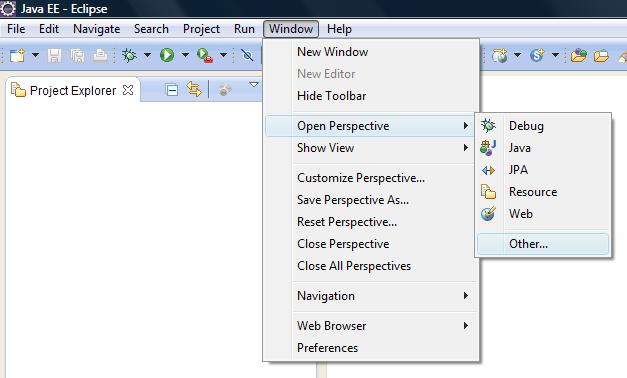
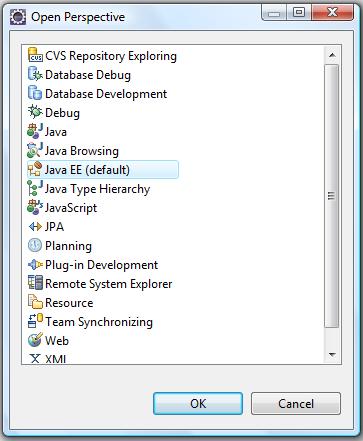
Open Project Explorer view. From the menu bar select, Window > Show View > Project Explorer.
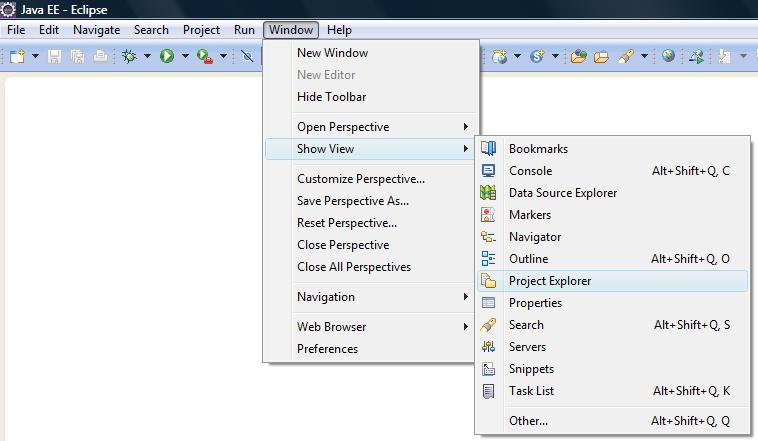
Right click anywhere in project explorer view. Select New > Dynamic Web Project.

A pop up window will open up, we will enter the details for creating the dynamic web project. Enter Project name : Library_SpringMVC. Select Target Runtime as Apache Tomcat v7.0. Also ensure that configuration is set as Default Configuration for Apache Tomcat v7.0. Please ensure that the Apache Tomcat v7.0 is already installed on the system and is integrated with the Eclipse IDE.
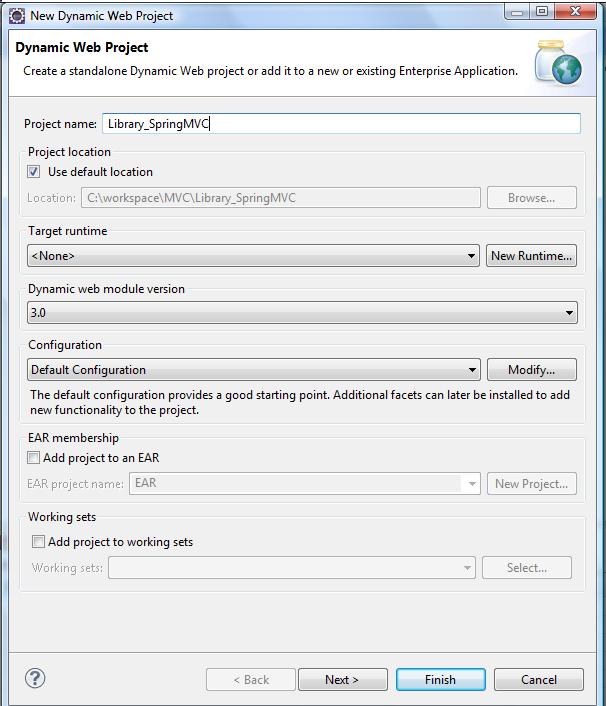
Click the Next button on the Dynamic Web Project dialogue. The next dialogue is for Java settings for the project. Add the following two source folders using Add Folder... button on the right hand side of the Java dialogue.
1. SourceCode/JavaSource - All the java code of our sample application will reside here.
2. SourceCode/Config - All the XML and properties files of our sample application will reside here.
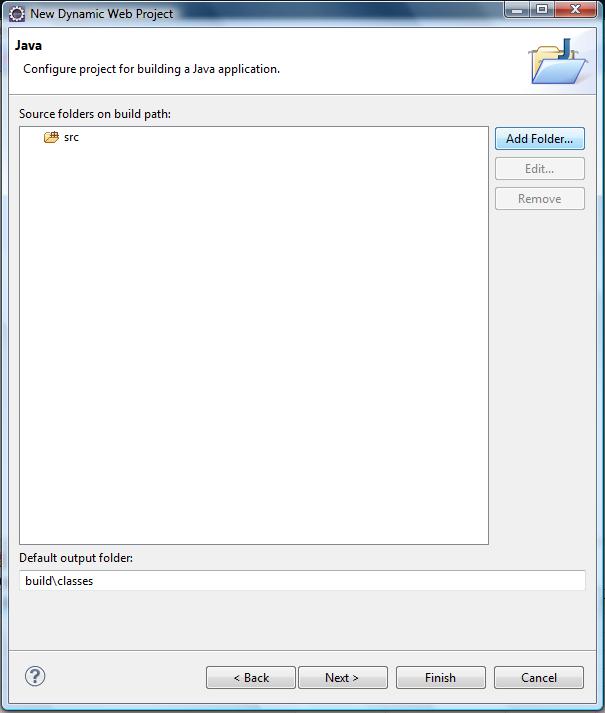
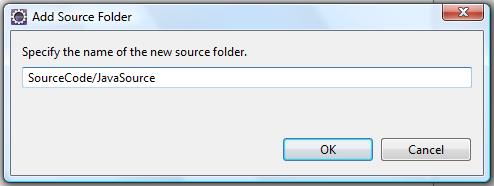
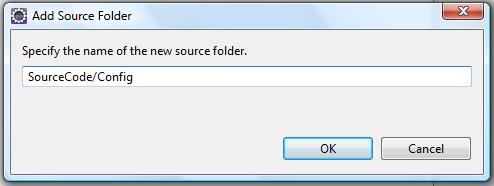
Click on the Next button on the Java dialogue. The next dialogue is for Web Module. In this dialgoue, ensure that the Context root is set as Library, Content directory is set as WebContent and ensure that check box corresponding to Generate web.xml deployment descriptor is checked.
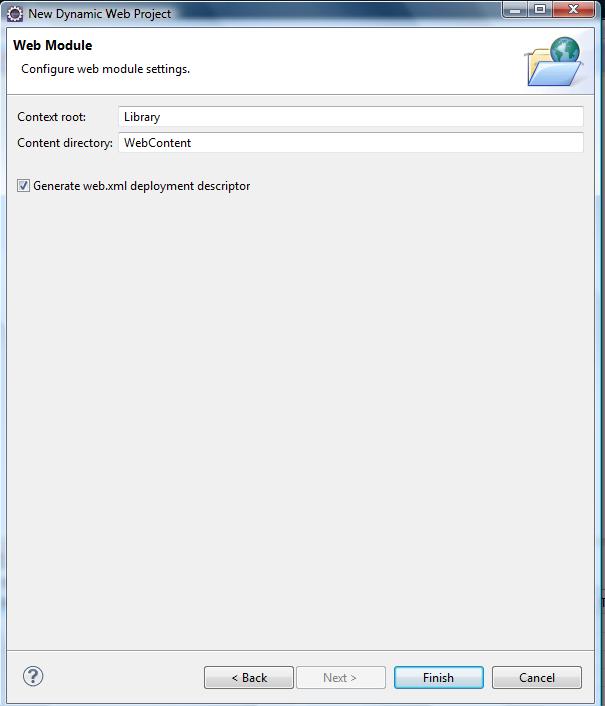
When you click the Finish button, the dynamic web project with name Library_SpringMVC will be created in your workspace.
Create folder for JSP pages: We will place all the JSP pages in folder WebContent/WEB-INF/jsp. Thus we need to create the folder with name jsp within WEB-INF folder. Right click the WEB-INF folder and select New>folder. Enter the name as jsp.
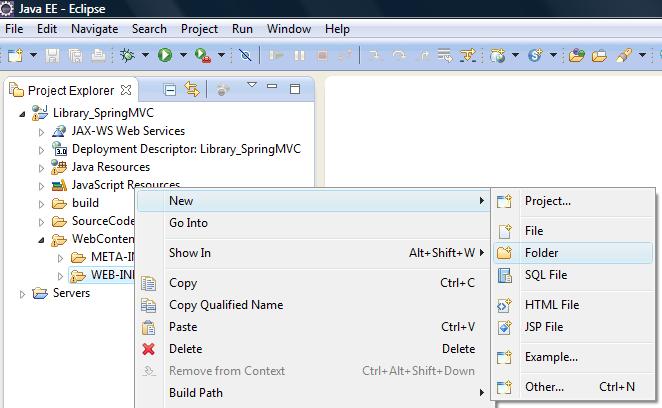
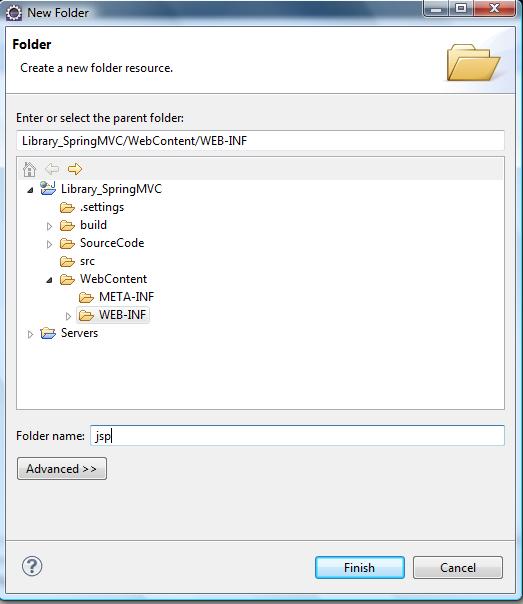
The various jar files which are required to build and run our sample application based on Spring MVC are as below:
- spring-beans-3.2.0.M2.jar
- spring-context-3.2.0.M2.jar
- spring-core-3.2.0.M2.jar
- spring-expression-3.2.0.M2.jar
- spring-web-3.2.0.M2.jar
- spring-webmvc-3.2.0.M2.jar
The above jars can be downloaded from following location: https://repo.springsource.org/libs-milestone-local/org/springframework/spring/3.2.0.M2/spring-3.2.0.M2-dist.zip
Download the zip file from above location. Unzip it. Copy the relevant jars (as mentioned above) from spring-3.2.0.M2\libs to the lib folder of the sample java application.
We also need following jars:
- commons-logging-1.1.1.jar - This jar is required for logging. Spring MVC jars (mentioned above) require this jar file.
Down the jar from the following location and copy it in the lib folder present in the project.
http://apache.techartifact.com/mirror/commons/logging/binaries/commons-logging-1.1.1-bin.zip
Following two jar files are required for using Java Tag Library in JSP pages.
- javax.servlet.jsp.jstl-1.2.2.jar
Down the jar from the following location and copy it in the lib folder present in the project.
- javax.servlet.jsp.jstl-api-1.2.1.jar
Down the jar from the following location and copy it in the lib folder present in the project.
Coding the model
The various application objects used in our sample applications are:
- Book
- Chapter
- Title
Book object consist of:
- Title – Represented by Title object
- Author – Represented by String
- ISBN – Represented by integer
- List of Chapters – Represented by List<Chapter>
Chapter object consist of:
- Number – Chapter number represented by integer
- Title – Represented by Title object
- Content – Content of the chapter represented by String
Title object consist of:
- titleValue – Represented by String
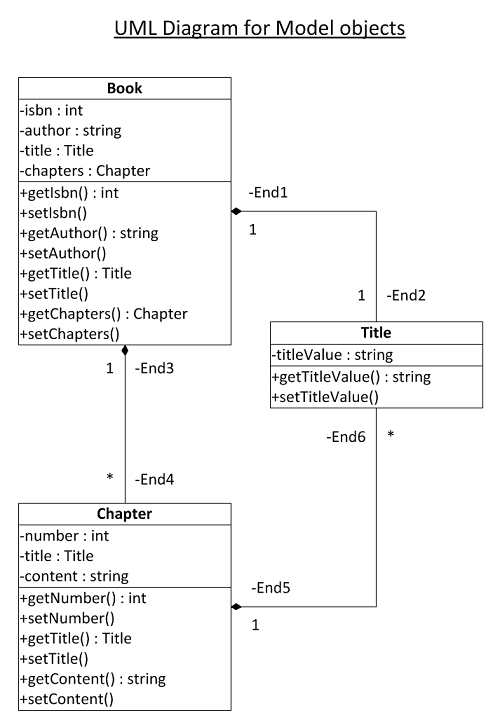
UML Diagram for our sample application Model objects
The java classes for the application objects are placed within source folder SourceCode/JavaSource. The java code of our application objects looks as below:
Title.java
package net.codejava.frameworks.spring.bo;
public class Title {
private String titleValue;
public Title(){
}
public Title(String titleValue){
this.titleValue = titleValue;
}
public String getTitleValue() {
return titleValue;
}
public void setTitleValue(String titleValue) {
this.titleValue = titleValue;
}
}Chapter.java
package net.codejava.frameworks.spring.bo;
public class Chapter {
private int number;
private Title title;
private String content;
public Chapter(){
}
public Chapter(int number, Title title, String content){
this.number = number;
this.title = title;
this.content = content;
}
public int getNumber() {
return number;
}
public void setNumber(int number) {
this.number = number;
}
public Title getTitle() {
return title;
}
public void setTitle(Title title) {
this.title = title;
}
public String getContent() {
return content;
}
public void setContent(String content) {
this.content = content;
}
}Book.java
package net.codejava.frameworks.spring.bo;
import java.util.List;
public class Book {
private int isbn;
private String author;
private Title title;
private List<Chapter> chapters;
public Book(){
}
public Book(int isbn, String author, Title title, List<Chapter> chapters){
this.isbn = isbn;
this.author = author;
this.title = title;
this.chapters = chapters;
}
public int getIsbn() {
return isbn;
}
public void setIsbn(int isbn) {
this.isbn = isbn;
}
public String getAuthor() {
return author;
}
public void setAuthor(String author) {
this.author = author;
}
public Title getTitle() {
return title;
}
public void setTitle(Title title) {
this.title = title;
}
public List<Chapter> getChapters() {
return chapters;
}
public void setChapters(List<Chapter> chapters) {
this.chapters = chapters;
}
}All the book beans are defined in XML file books.xml, all the chapter beans are defined in chapters.xml and all the title beans are defined in titles.xml file. All these XML files are placed within SourceCode/Config folder.
The various Spring’s application context files look as below:
titles.xml
<?xml version="1.0" encoding="UTF-8"?>
<beans xmlns="http://www.springframework.org/schema/beans"
xmlns:xsi="http://www.w3.org/2001/XMLSchema-instance"
xsi:schemaLocation="http://www.springframework.org/schema/beans
http://www.springframework.org/schema/beans/spring-beans-3.0.xsd">
<bean class="org.springframework.beans.factory.config.PropertyPlaceholderConfigurer">
<property name="location">
<value>classpath:beans.properties</value>
</property>
</bean>
<bean id="bookTitle" class="net.codejava.frameworks.spring.bo.Title">
<property name="titleValue">
<value>${myFirstSpringBook.title}</value>
</property>
</bean>
<bean id="chapter1Title" class="net.codejava.frameworks.spring.bo.Title">
<constructor-arg>
<value>${myFirstSpringBook.chapter1.title}</value>
</constructor-arg>
</bean>
<bean id="chapter2Title" class="net.codejava.frameworks.spring.bo.Title">
<constructor-arg>
<value>${myFirstSpringBook.chapter2.title}</value>
</constructor-arg>
</bean>
<bean id="chapter3Title" class="net.codejava.frameworks.spring.bo.Title">
<property name="titleValue">
<value>${myFirstSpringBook.chapter3.title}</value>
</property>
</bean>
</beans>chapters.xml
<?xml version="1.0" encoding="UTF-8"?>
<beans xmlns="http://www.springframework.org/schema/beans"
xmlns:xsi="http://www.w3.org/2001/XMLSchema-instance"
xsi:schemaLocation="http://www.springframework.org/schema/beans
http://www.springframework.org/schema/beans/spring-beans-3.0.xsd">
<bean class="org.springframework.beans.factory.config.PropertyPlaceholderConfigurer">
<property name="location">
<value>classpath:beans.properties</value>
</property>
</bean>
<bean id="chapter1" class="net.codejava.frameworks.spring.bo.Chapter">
<property name="number">
<value>1</value>
</property>
<property name="content">
<value>${myFirstSpringBook.chapter1.content}</value>
</property>
<property name="title">
<ref bean="chapter1Title"/>
</property>
</bean>
<!-- injecting the dependencies of chapter 2 using constructor by index -->
<bean id="chapter2" class="net.codejava.frameworks.spring.bo.Chapter">
<constructor-arg index="0">
<value>2</value>
</constructor-arg>
<constructor-arg index="1">
<ref bean="chapter2Title"/>
</constructor-arg>
<constructor-arg index="2">
<value>${myFirstSpringBook.chapter2.content}</value>
</constructor-arg>
</bean>
<!-- injecting the dependencies of chapter 3 using constructor by type -->
<bean id="chapter3" class="net.codejava.frameworks.spring.bo.Chapter">
<constructor-arg type="int">
<value>3</value>
</constructor-arg>
<constructor-arg type="net.codejava.frameworks.spring.bo.Title">
<ref bean="chapter3Title"/>
</constructor-arg>
<constructor-arg type="String">
<value>${myFirstSpringBook.chapter3.content}</value>
</constructor-arg>
</bean>
</beans>books.xml
<?xml version="1.0" encoding="UTF-8"?>
<beans xmlns="http://www.springframework.org/schema/beans"
xmlns:xsi="http://www.w3.org/2001/XMLSchema-instance"
xsi:schemaLocation="http://www.springframework.org/schema/beans
http://www.springframework.org/schema/beans/spring-beans-3.0.xsd">
<bean class="org.springframework.beans.factory.config.PropertyPlaceholderConfigurer">
<property name="location">
<value>classpath:beans.properties</value>
</property>
</bean>
<bean id="myFirstSpringBook" class="net.codejava.frameworks.spring.bo.Book">
<property name="isbn">
<value>1</value>
</property>
<property name="author">
<value>${myFirstSpringBook.author}</value>
</property>
<property name="title">
<ref bean="bookTitle"/>
</property>
<property name="chapters">
<list>
<ref bean="chapter1"/>
<ref bean="chapter2"/>
<ref bean="chapter3"/>
</list>
</property>
</bean>
</beans>Note that we have used the beans.properties file in the above XML files. The beans.properties file looks as below:
myFirstSpringBook.title=My First Spring Book myFirstSpringBook.chapter1.title=Spring framework - Chapter 1 myFirstSpringBook.chapter2.title=Spring framework - Chapter 2 myFirstSpringBook.chapter3.title=Spring framework - Chapter 3 myFirstSpringBook.chapter1.content=The content of chapter 1 goes here. myFirstSpringBook.chapter2.content=The content of chapter 2 goes here. myFirstSpringBook.chapter3.content=The content of chapter 3 goes here. myFirstSpringBook.author=Mr. XYZ
Configure the Spring’s front controller (DispatcherServlet)
Open Web.xml file present in the Library project at location WebContent/WEB-INF. Configure the dispatcher Servlet and servlet mapping as shown below.
<web-app
xsi:schemaLocation="http://java.sun.com/xml/ns/javaee http://java.sun.com/xml/ns/javaee/web-app_2_5.xsd"
id="WebApp_ID"
version="2.5"
xmlns:xsi="http://www.w3.org/2001/XMLSchema-instance"
xmlns="http://java.sun.com/xml/ns/javaee"
xmlns:web="http://java.sun.com/xml/ns/javaee/web-app_2_5.xsd">
<display-name>Library</display-name>
<servlet>
<servlet-name>myLibraryAppFrontController</servlet-name>
<servlet-class>org.springframework.web.servlet.DispatcherServlet</servlet-class>
<init-param>
<param-name>contextConfigLocation</param-name>
<param-value>classpath:libraryAppContext.xml
classpath:books.xml
classpath:chapters.xml
classpath:titles.xml</param-value>
</init-param>
<load-on-startup>1</load-on-startup>
</servlet>
<servlet-mapping>
<servlet-name>myLibraryAppFrontController</servlet-name>
<url-pattern>*.htm</url-pattern>
</servlet-mapping>
<welcome-file-list>
<welcome-file>welcome.htm</welcome-file>
</welcome-file-list>
</web-app>Here servlet name is myLibraryAppFrontController. URI pattern in servlet mapping is *.htm.
There is one initialization parameter given to the servlet. The initialization parameter name is contextConfigLocation and its values are
classpath:libraryAppContext.xml classpath:books.xml classpath:chapters.xml classpath:titles.xml
This ensures that the container looks for the mentioned XML files to load the Spring application context instead of looking for default XML file “WEB-INB/myLibraryAppFrontController-servelt.xml”
Create the XML file with name libraryAppContext.xml in folder SourceCode/Config. This is the Spring’s application context file which will contain the Spring MVC specific beans. The various beans defined in this file are:
- HandlerMapping maps the request with the controller bean. We have used SimpleUrlHandlerMapping. Web page /welcome.htm will be served by controller with bean name welcomeController, /listBooks.htm will be served by controller with bean name listBooksController and /displayBookTOC.htm will be served by controller with bean name displayBookTOCController.
- Three controller beans serving the request for three web pages.
- ViewResolver bean resolves the view logical name to the JSP file. We have used InternalResourceViewResolver with prefix as /WEB-INF/jsp and suffix as .jsp. This is because we have placed our view objects in this folder.
libraryAppContext.xml file will look as below
<?xml version="1.0" encoding="UTF-8"?>
<beans xmlns="http://www.springframework.org/schema/beans"
xmlns:xsi="http://www.w3.org/2001/XMLSchema-instance"
xsi:schemaLocation="http://www.springframework.org/schema/beans
http://www.springframework.org/schema/beans/spring-beans-3.0.xsd">
<bean
class="org.springframework.beans.factory.config.PropertyPlaceholderConfigurer">
<property name="location">
<value>classpath:beans.properties</value>
</property>
</bean>
<bean id="myHandlerMapping" class="org.springframework.web.servlet.handler.SimpleUrlHandlerMapping">
<property name="mappings">
<props>
<prop key="/welcome.htm">welcomeController</prop>
<prop key="/listBooks.htm">listBooksController</prop>
<prop key="/displayBookTOC.htm">displayBookTOCController</prop>
</props>
</property>
</bean>
<bean name="welcomeController" class="net.codejava.frameworks.spring.mvc.controller.WelcomeController" />
<bean name="listBooksController" class="net.codejava.frameworks.spring.mvc.controller.ListBooksController">
<property name="books">
<list>
<ref bean="myFirstSpringBook"/>
</list>
</property>
</bean>
<bean name="displayBookTOCController" class="net.codejava.frameworks.spring.mvc.controller.DisplayBookTOCController">
<property name="books">
<list>
<ref bean="myFirstSpringBook"/>
</list>
</property>
</bean>
<bean id="viewResolver" class="org.springframework.web.servlet.view.InternalResourceViewResolver">
<property name="prefix" value="/WEB-INF/jsp/" />
<property name="suffix" value=".jsp" />
</bean>
</beans>Coding the controller
Let us have a quick look on the three controllers. All the three controllers extends AbstractController and override method handleRequestInternal. This method returns an object of ModelAndView which contains the logical name of the view and the model object.
In case of welcomeBookController the logical name of the view is Welcome and there is no model object being returned.
package net.codejava.frameworks.spring.mvc.controller;
import javax.servlet.http.HttpServletRequest;
import javax.servlet.http.HttpServletResponse;
import org.springframework.web.servlet.ModelAndView;
import org.springframework.web.servlet.mvc.AbstractController;
public class WelcomeController extends AbstractController {
@Override
protected ModelAndView handleRequestInternal(HttpServletRequest request,
HttpServletResponse response) throws Exception {
return new ModelAndView("welcome");
}
}In case of listBooksController, the logical name of the view is listBooks and the model object being returned is the list of books objects.
package net.codejava.frameworks.spring.mvc.controller;
import java.util.List;
import javax.servlet.http.HttpServletRequest;
import javax.servlet.http.HttpServletResponse;
import net.codejava.frameworks.spring.bo.Book;
import org.springframework.web.servlet.ModelAndView;
import org.springframework.web.servlet.mvc.AbstractController;
public class ListBooksController extends AbstractController {
private List<Book> books;
@Override
protected ModelAndView handleRequestInternal(HttpServletRequest request,
HttpServletResponse response) throws Exception {
return new ModelAndView("listBooks","books",books);
}
public List<Book> getBooks() {
return books;
}
public void setBooks(List<Book> books) {
this.books = books;
}
}In case of displayBookTOCController, the logical name of the view is displayBookTOC and the model object being returned is the object of the book whose ISBN is being passed in the request.
package net.codejava.frameworks.spring.mvc.controller;
import java.util.List;
import javax.servlet.http.HttpServletRequest;
import javax.servlet.http.HttpServletResponse;
import net.codejava.frameworks.spring.bo.Book;
import org.springframework.web.servlet.ModelAndView;
import org.springframework.web.servlet.mvc.AbstractController;
public class DisplayBookTOCController extends AbstractController {
private List<Book> books;
@Override
protected ModelAndView handleRequestInternal(HttpServletRequest request,
HttpServletResponse response) throws Exception {
Book myBook = null;
if(books != null && !books.isEmpty()){
for(Book book : books){
if(book.getIsbn() == Integer.parseInt(request.getParameter("isbn"))){
myBook = book;
break;
}
}
}
return new ModelAndView("displayBookTOC","book",myBook);
}
public List<Book> getBooks() {
return books;
}
public void setBooks(List<Book> books) {
this.books = books;
}
}Coding the View
The various JSPs being displayed to the user are placed within WebContent/WEB-INF/jsp folder. The JSPs are as below:
Welcome.jsp
<%@ page language="java" contentType="text/html; charset=ISO-8859-1" pageEncoding="ISO-8859-1"%>
<!DOCTYPE html PUBLIC "-//W3C//DTD HTML 4.01 Transitional//EN" "http://www.w3.org/TR/html4/loose.dtd">
<html>
<head>
<meta http-equiv="Content-Type" content="text/html; charset=ISO-8859-1"/>
<title>Welcome page</title>
</head>
<body>
<h1>Welcome to the world of books !</h1>
<p>The page content goes here . . .</p>
<a href="/listBooks.htm">List all books.</a>
</body>
</html>listBooks.jsp
<%@ page language="java"
contentType="text/html; charset=ISO-8859-1"
pageEncoding="ISO-8859-1"%>
<%@ taglib prefix="c" uri="http://java.sun.com/jsp/jstl/core" %>
<html>
<head>
<meta http-equiv="Content-Type" content="text/html; charset=ISO-8859-1"/>
<title>List of books</title>
</head>
<body>
<h1 align="center">List of books in my library :</h1>
<table width="50%" align="center">
<tr>
<th width="20%" align="center">S. No.</th>
<th width="50%" align="center">Title</th>
<th width="30%" align="center">Author</th>
</tr>
<%int i = 1; %>
<c:forEach items="${books}" var="book">
<tr>
<td width="20%" align="center"><%= i++ %></td>
<td width="50%" align="center">
<a href="/displayBookTOC.htm?isbn=${book.isbn}">${book.title.titleValue}</a>
</td>
<td width="30%" align="center">${book.author}</td>
</tr>
</c:forEach>
</table>
</body>
</html>displayBookTOC.jsp
<%@ page language="java" contentType="text/html; charset=ISO-8859-1" pageEncoding="ISO-8859-1"%>
<%@ taglib prefix="c" uri="http://java.sun.com/jsp/jstl/core" %>
<!DOCTYPE html PUBLIC "-//W3C//DTD HTML 4.01 Transitional//EN" "http://www.w3.org/TR/html4/loose.dtd">
<html>
<head>
<meta http-equiv="Content-Type" content="text/html; charset=ISO-8859-1">
<title>Book Table of Content</title>
</head>
<body>
<h1 align="center">Book : ${book.title.titleValue}, written by ${book.author}</h1>
<h2>Table of content : </h2>
<%int i = 1; %>
<table width="100%">
<c:forEach items="${book.chapters}" var="chapter">
<tr width="100%">
<td width="5%" align="center"><%= i++ %></td>
<td width="95%" align="left">${chapter.title.titleValue}</td>
</tr>
</c:forEach>
</table>
</body>
</html>Finally our Library_SpringMVC project in Eclipse IDE will look as below.
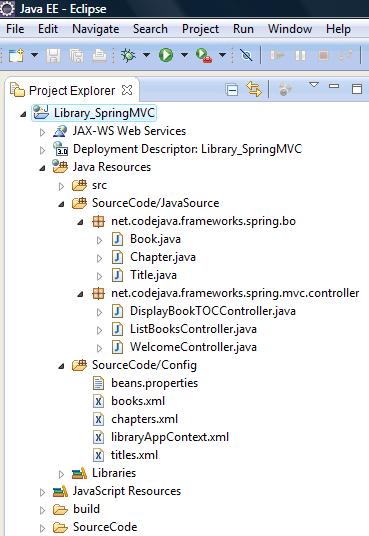

Create Tomcat Server in Eclipse IDE
From the menu bar, select Windows > Show View > Servers. The server view gets opened up.
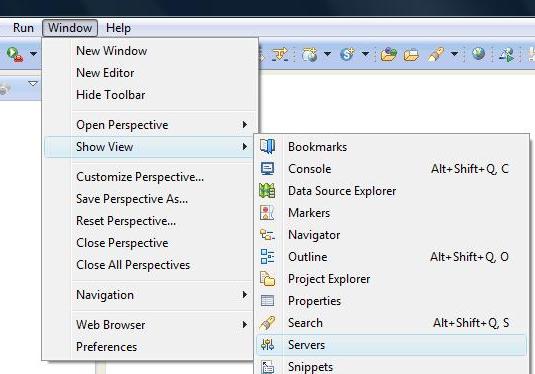
Click the link new server wizard on the server view.

In the pop up window which gets open up, Enter Server’s host name as localhost, Server Type as Apache > Tomcat v7.0 Server and Server runtime as Apache Tomcat v7.0. Click the finish button.

Click the Finish button and the Apache Tomcat v7.0 Server will start appearing in the server view.

Deploying the application
Right click on the server created above. Select Add and Remove Projects.

In the pop up window which gets open up, Library_SpringMVC project will appear on the list of Available projects. Select the Library_SpringMVC project and move it to Configured projects. Click the Finish button.
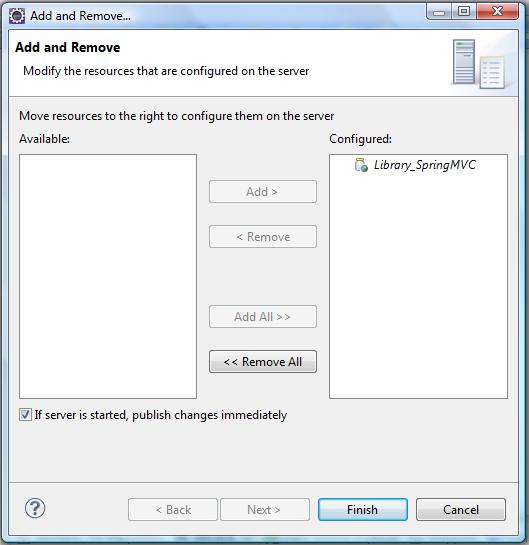
Click the Finish button in the above dialogue box. Now right click the server and select Start.
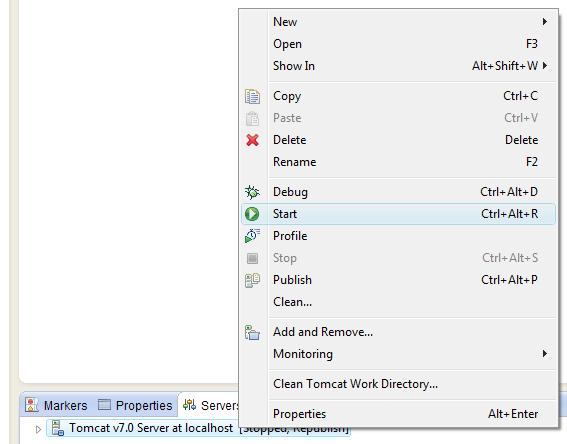
Our library application is now deployed on the Apache Tomcat server.
Testing the application
Open the web browser. Enter the following URL (Note that the Tomcat server is running on port 8080). http://localhost:8080/Library/welcome.htm
The welcome page of Library application will be displayed on the browser.
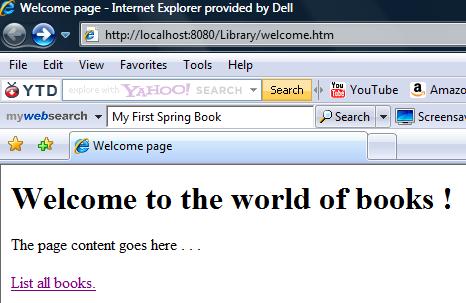
Click the hyperlink List all books (http://localhost:8080/Library/listBooks.htm) on the welcome page. This will show the listBooks.htm page on the browser with the list of books (Model).

Click the hyperlink My First Spring Book (http://localhost:8080/Library/displayBookTOC.htm?isbn=1). The browser will render the displayBookTOC.htm page of our library application with the details of the book with ISBN = 1 (Model).
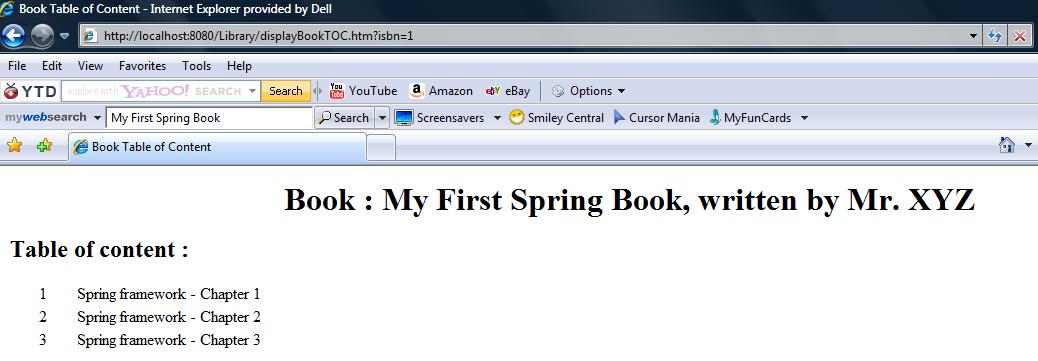
8. Conclusion
In this article we have learned how the Spring framework makes the development of web application very simple and easy. We have learned the Spring’s MVC module in detail, its architecture and various components. We have also learned the design patterns on which Spring’s MVC module is based upon. Finally we have built a simple application using Eclipse IDE.
I recommend you take Spring Boot E-Commerce Ultimate Course to Learn to Build a complete shopping website using Java, Spring Boot, Thymeleaf, Bootstrap, jQuery and MySQL database. In this course, you will learn how Spring MVC is used extensively to build such an e-commerce website application.
Other Spring Tutorials:
- Understand the core of Spring framework
- Understand Spring AOP
- Spring Dependency Injection Example with XML Configuration
- Spring MVC beginner tutorial with Spring Tool Suite IDE
- Spring MVC Form Handling Tutorial
- Spring MVC Form Validation Tutorial
- 14 Tips for Writing Spring MVC Controller
- Spring Web MVC Security Basic Example (XML Configuration)
- Understand Spring Data JPA with Simple Example
About the Author:
 Nam Ha Minh is certified Java programmer (SCJP and SCWCD). He began programming with Java back in the days of Java 1.4 and has been passionate about it ever since. You can connect with him on Facebook and watch his Java videos on YouTube.
Nam Ha Minh is certified Java programmer (SCJP and SCWCD). He began programming with Java back in the days of Java 1.4 and has been passionate about it ever since. You can connect with him on Facebook and watch his Java videos on YouTube.
Comments
Can you create a new blog on it please ?
How to learn complete banking website
Using spring web mvc with hibernate